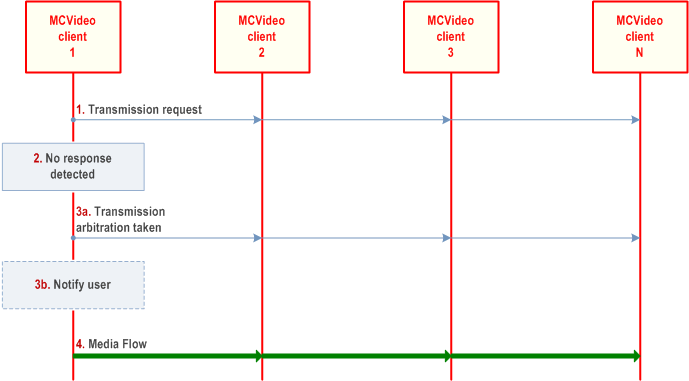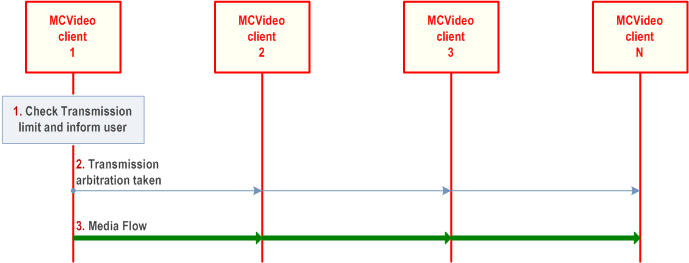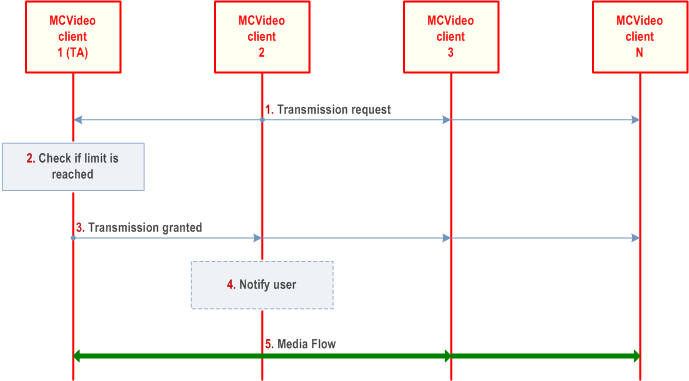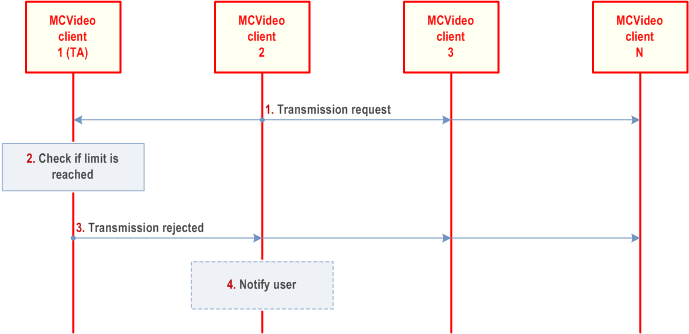Content for TS 23.281 Word version: 19.2.0
1…
5…
6…
7…
7.1.2.3…
7.1.2.3.1.2…
7.1.2.3.2…
7.1.2.4…
7.1.2.5.2…
7.1.3…
7.2…
7.2.2.3…
7.2.2.4…
7.2.3…
7.3…
7.4…
7.4.3…
7.5…
7.5.2.3…
7.6…
7.7…
7.7.1.3…
7.7.1.3.2A…
7.7.1.3.4…
7.7.1.3.6…
7.7.2…
7.7.2.7…
7.7.2.9…
7.8…
7.11…
7.17…
7.19…
7.19.2.8…
7.19.3…
7.19.3.1.4…
7.19.3.2…
7.19.3.2.3…
7.19.3.2.6…
A…
7.7.2 Off-network transmission control
7.7.2.1 General
7.7.2.2 Information flows for off-network transmission control
7.7.2.2.1 Transmission request
7.7.2.2.2 Transmission granted
7.7.2.2.3 Transmission release
7.7.2.2.4 Transmission rejected
7.7.2.2.5 Transmission revoked
7.7.2.2.6 Transmission arbitration taken
7.7.2.2.7 Transmission arbitration release
7.7.2.3 Initializing transmission control - single arbitrator approach
7.7.2.3A Initializing transmission control - self arbitration approach
7.7.2.4 Transmission permission granted
7.7.2.5 Transmission permission rejected
7.7.2.6 Releasing transmission permission
...
...
7.7.2 Off-network transmission control p. 148
7.7.2.1 General p. 148
The procedure is for providing transmission control to MCVideo UE in an off-network case. Transmission control is performed by using transmission control information flows between the transmission control participant and the transmission control arbitrator. The transmission control arbitrator is a member MCVideo UE of the MCVideo group where the transmission rules are applied.
Off-network transmission control is based on ProSe capabilities as described in clause 7.18.
Transmission control in off-network can be performed in two ways:
- Single arbitrator: transmission participants rely on a single participant designated as transmission arbitrator for the arbitraton of transmission requests.
- Self arbitration: each transmsission participant arbitrates its own transmission based on its view of the topology.
7.7.2.2 Information flows for off-network transmission control p. 149
7.7.2.2.1 Transmission request p. 149
Table 7.7.2.2.1-1 describes the information flow for the transmission request sent by a transmission participant to request for the transmission permission. This information flows is sent in unicast or broadcast.
| Information Element | Status | Description |
|---|---|---|
| MCVideo ID | M | The identity of the MCVideo user requesting the transmission permission |
| Transmission priority | M | Priority of the request |
| Source identifier | O | Identifies the communication, e.g. by identifying the media flow within a media multiplex, present only if media multiplexing |
7.7.2.2.2 Transmission granted p. 149
Table 7.7.2.2.2-1 describes the information flow for the transmission granted sent by the transmission arbitrator, to indicate that a request for transmission is granted and media may be transmitted. This information flows is sent in unicast or broadcast.
| Information Element | Status | Description |
|---|---|---|
| MCVideo ID | M | Identity of the user whose client is acting as transmission arbitrator |
| MCVideo ID | M | Identity of the user that has been granted transmission permission |
| Duration | M | The time for which the granted party is allowed to transmit |
| Source identifier | O | Identifies the communication, e.g. by identifying the media flow within a media multiplex, present only if media multiplexing |
| MCVideo ID of subsequent arbitrator | O | Subsequent transmission arbitrator's identity |
| Acknowledgement required | O | Indicates if acknowledgement from the transmission participant is required |
7.7.2.2.3 Transmission release p. 150
Table 7.7.2.2.3-1 describes the information flow for transmission release sent by the transmission participant, to indicate that the media transmission is complete and transmission permission is released. This information flows is sent in unicast or broadcast.
| Information Element | Status | Description |
|---|---|---|
| MCVideo ID | M | Identity of user releasing transmission |
| Source identifier | O | Identifies the communication, e.g. by identifying the media flow within a media multiplex, present only if media multiplexing |
7.7.2.2.4 Transmission rejected p. 150
Table 7.7.2.2.4-1 describes the information flow for transmission rejected sent by the transmission arbitrator, to indicate that a request for the transmission is rejected. This information flows is sent in unicast or broadcast.
| Information Element | Status | Description |
|---|---|---|
| MCVideo ID | M | Identity of the user whose client is acting as transmission arbitrator |
| MCVideo ID of rejected party | M | Identity of user whose transmission request has been rejected |
| Source identifier | O | Identifies the communication, e.g. by identifying the media flow within a media multiplex, present only if media multiplexing |
| Rejection cause | O | Indicates the cause for transmission rejection |
| Acknowledgement required | O | Indicates if acknowledgement from the transmission participant is required |
7.7.2.2.5 Transmission revoked p. 150
Table 7.7.2.2.5-1 describes the information flow for transmission revoked sent by the transmission arbitrator, to indicate that the transmission permission, that was earlier granted, is revoked. This information flows is sent in unicast or broadcast.
| Information Element | Status | Description |
|---|---|---|
| MCVideo ID | M | Identity of the user whose client is acting as transmission arbitrator |
| MCVideo ID | M | Identity of user whose transmission permission has been revoked |
| Source identifier | O | Identifies the communication, e.g. by identifying the media flow within a media multiplex, present only if media multiplexing |
| Acknowledgement required | O | Indicates if acknowledgement from the transmission participant is required |
7.7.2.2.6 Transmission arbitration taken p. 151
Table 7.7.2.2.6-1 describes the information flow for transmission taken sent by the transmission participant, to indicate that the transmission participant has taken the responsibility of transmission arbitration. This information flows is sent in unicast or broadcast.
| Information Element | Status | Description |
|---|---|---|
| MCVideo ID | M | Identity of the MCVideo user taking responsibility of transmission arbitration |
| Source identifier | O | Identifies the communication, e.g. by identifying the media flow within a media multiplex, present only if media multiplexing |
| Permission to request the transmission | O | Indicates whether receiving parties are allowed to request the transmission or not (e.g. broadcast call). |
| Acknowledgement required | O | Indicates if acknowledgement from the transmission participant is required |
7.7.2.2.7 Transmission arbitration release p. 151
Table 7.7.2.2.7-1 describes the information flow for transmission arbitration release sent by the transmission arbitrator, to indicate that the responsibility of transmission arbitration is released. This information flows is sent in unicast or broadcast.
| Information Element | Status | Description |
|---|---|---|
| MCVideo ID | M | Identity of the user whose client is acting as transmission arbitrator |
| MCVideo ID | O | Identity of the user whose client is being delegated transmission arbitrator function |
| Source identifier | O | Identifies the communication, e.g. by identifying the media flow within a media multiplex, present only if media multiplexing |
7.7.2.3 Initializing transmission control - single arbitrator approach p. 151
This subclause is applicable only in single arbitrator approach.
Figure 7.7.2.3-1 describes procedures for transmission participants when an MCVideo client initializes transmission control. The MCVideo client sends a transmission request to detect presence of a transmission arbitrator. If the MCVideo client does not receive a response to the transmission request, it sends a transmission arbitration taken message and becomes the transmission arbitrator. The MCVideo client may now transmit a video. This procedure applies when either there have been no recent MCVideo transmissions within the MCVideo group and therefore no arbitrator has been selected, or where there have been recent MCVideo transmissions which may still be ongoing, but the arbitrator cannot be reached, e.g. where MCVideo client that wants to transmit video has gone out of range of the arbitrator.
Pre-conditions:
- An off-network group communication has been established.
- MCVideo client 1 wishes to transmit video, and has determined that the pre-configured limit on the number of transmissions within the MCVideo group has not been reached.

Step 1.
MCVideo client 1 sends a transmission request message to the MCVideo group.
Step 2.
MCVideo client 1 does not detect any response to the transmission request.
Step 3a.
MCVideo client 1 sends a transmission arbitration taken message to the MCVideo group.
Step 3b.
MCVideo user may be notified that the video can now be transmitted.
Step 4.
MCVideo client 1 transmits video to the MCVideo group.
7.7.2.3A Initializing transmission control - self arbitration approach p. 152
This subclause is applicable only in self arbitration approach.
Figure 7.7.2.3a-1 describes procedures for transmission participants when an MCVideo client initializes transmission control.
Pre-conditions:
- An off-network group communication has been established.
- MCVideo client 1 wishes to transmit video.

Step 1.
The MCVideo client checks whether the pre-configured limit on the number of transmissions within the MCVideo group has been reached and informs the user. If the pre-configured limit on the number of transmissions within the MCVideo group has been reached, the MCVideo user may defer the transmission, or request an override as specified in subclause 7.7.2.8, or decide to continue with the transmission anyway.
Step 2.
MCVideo client 1 sends a transmission arbitration taken message to the MCVideo group.
Step 3.
MCVideo client 1 transmits video to the MCVideo group.
7.7.2.4 Transmission permission granted p. 153
This subclause is applicable only in single arbitrator approach.
Figure 7.7.2.4-1 describes procedures for transmission participants when an MCVideo client requests for transmission permission.
The MCVideo client has detected presence of a transmission arbitrator e.g., by receiving responses to transmission arbitration control message. The MCVideo client sends a transmission request and waits for a response. The MCVideo client upon receiving a transmission granted message may transmit a video.
Pre-conditions:
- An off-network group communication has been established.
- At least one participant is currently transmitting video.

Step 1.
MCVideo client 2 sends a transmission request message to the MCVideo group.
Step 2.
MCVideo client 1, being the transmission arbitrator, checks if the configured limit of maximum simultaneous transmissions is already reached.
Step 3.
If the maximum simultaneous transmissions limit is not reached, MCVideo client 1 sends a transmission granted message to the MCVideo group. Transmission granted message indicates MCVideo client 2 as the intended recipient.
Step 4.
MCVideo user at MCVideo client 2 may be notified that the video can now be transmitted.
Step 5.
MCVideo client 2 transmits video to the MCVideo group.
7.7.2.5 Transmission permission rejected p. 154
This subclause is applicable only in single arbitrator approach.
Figure 7.7.2.5-1 describes procedures for transmission participants when an MCVideo client requests for transmission permission.
The MCVideo client has detected presence of a transmission arbitrator e.g., by receiving responses to transmission arbitration control message. The MCVideo client sends a transmission request and waits for a response.
Pre-conditions:
- An off-network group communication has been established.
- At least one participant is currently transmitting video.

Step 1.
MCVideo client 2 sends a transmission request message to the MCVideo group.
Step 2.
MCVideo client 1, being the transmission arbitrator, checks if the configured limit of maximum simultaneous transmissions is already reached.
Step 3.
If the maximum simultaneous transmissions limit has reached, MCVideo client 1 sends a transmission rejected message to the MCVideo group. Transmission denied message indicates MCVideo client 2 as the intended recipient. The transmission rejected message may include a rejection cause which indicates that the configured maximum transmissions limit has been reached.
Step 4.
MCVideo user at MCVideo client 2 may be notified that the video cannot be transmitted right now.
Following step 4, the MCVideo user at MCVideo client 2 may decide to transmit anyway, for example if the user knows the topology of the off-network MCVideo group and locations of the MCVideo group members and needs to transmit video to other local MCVideo group members despite causing a potential conflict with one or more other existing MCVideo transmissions within the MCVideo group. In this case, the MCVideo client follows the procedure in subclause 7.7.2.3.
7.7.2.6 Releasing transmission permission p. 155
This subclause is applicable in both the single arbitrator and self arbitration approaches.
Figure 7.7.2.6-1 describes procedures for transmission participants when an MCVideo client releases transmission permission.
The MCVideo client has detected presence of a transmission arbitrator e.g., by receiving responses to transmission arbitration control message. The MCVideo client stops the video transmission and sends a transmission release request.
Pre-conditions:
- An off-network group communication has been established.
- MCVideo client has requested transmission permission and may have received transmission permission.
